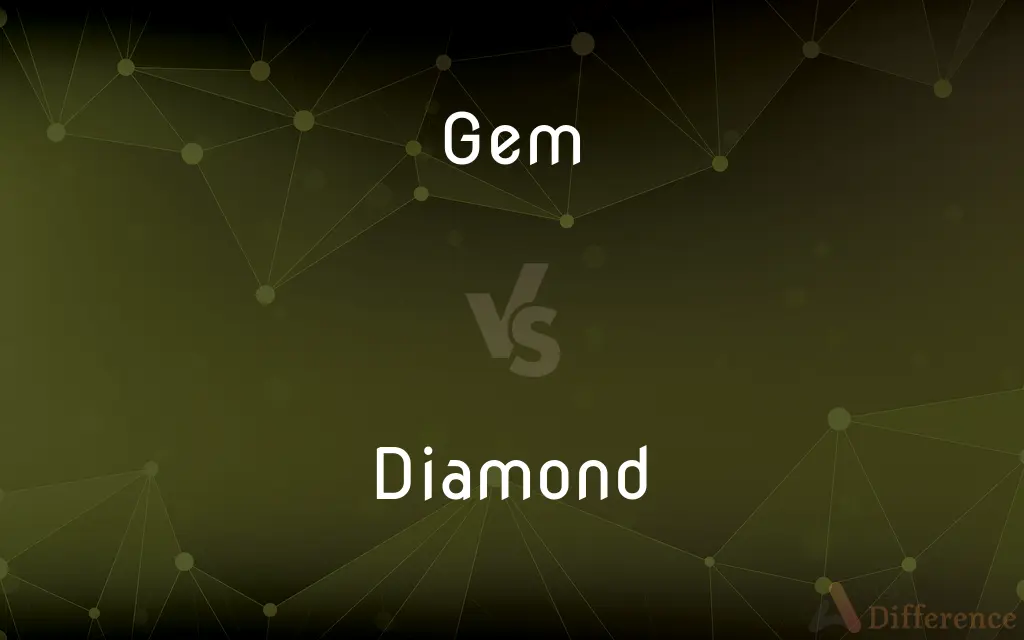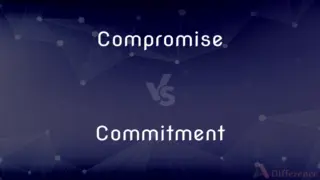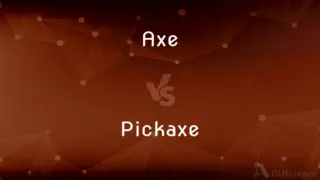Gem vs. Diamond — What's the Difference?
By Tayyaba Rehman & Fiza Rafique — Updated on April 20, 2024
A gem is any precious or semi-precious stone used in jewelry or decoration, while a diamond is a specific type of gemstone known for its exceptional hardness and brilliance.

Difference Between Gem and Diamond
Table of Contents
ADVERTISEMENT
Key Differences
Gems encompass a broad range of precious and semi-precious stones, including diamonds, rubies, sapphires, and emeralds. Each type of gem has unique properties, such as color, hardness, and rarity, which determine its value and use. Diamonds, specifically, are highly prized for their unmatched hardness and optical clarity, often making them the centerpiece of engagement rings and other high-value jewelry.
While gems can be either natural or synthetic, diamonds are often celebrated for their natural qualities, particularly those that are mined. However, synthetic diamonds have also gained popularity due to their lower cost and ethical sourcing. In contrast, synthetic versions of other gems, like sapphires and rubies, are commonly used as affordable alternatives in various jewelry pieces.
The value of a gem is generally determined by its color, clarity, cut, and carat weight—the four Cs. Diamonds are particularly renowned for their strict grading based on these criteria. While other gems are also evaluated on these factors, additional characteristics like rarity or historical significance can influence their market value.
Diamonds are composed of carbon atoms arranged in a crystal structure known as diamond lattice, which is responsible for their incredible durability and brilliance. Other gems, such as rubies and sapphires, are primarily composed of different minerals like corundum, and their colors are derived from various trace elements.
In terms of cultural significance, diamonds are often associated with luxury, status, and romance, particularly in Western cultures. Other gems also carry cultural meanings; for example, emeralds are often associated with rebirth and love, and sapphires symbolize wisdom and nobility.
ADVERTISEMENT
Comparison Chart
Types
Includes diamonds, rubies, sapphires, etc.
A specific type of gemstone
Composition
Varies widely (e.g., corundum for rubies and sapphires)
Pure carbon
Hardness
Ranges widely; some are very soft
Hardest natural substance on Mohs scale
Uses
Jewelry, decoration, industrial applications
Jewelry, cutting tools, optical applications
Value Determinants
Color, clarity, cut, carat, rarity
Extremely high value based on the four Cs plus high demand
Compare with Definitions
Gem
Semi-Precious.
Amethyst is a semi-precious gem, appreciated for its vibrant purple hue.
Diamond
Investment.
Diamonds are often bought as investments, retaining value over time.
Gem
Precious Stone.
Rubies are considered precious gems, highly valued for their deep red color.
Diamond
Carbon Structure.
Diamonds are prized for their structure, making them incredibly durable and reflective.
Gem
Synthetic Gems.
Lab-created sapphires offer a more affordable option for jewelry without compromising the visual appeal.
Diamond
Engagement Rings.
Diamonds are traditionally used in engagement rings as symbols of eternal love.
Gem
Cultural Significance.
In many cultures, gems like jade are worn as symbols of purity and protection.
Diamond
Industrial Use.
Due to their hardness, diamonds are essential in cutting and grinding tools.
Gem
Rarity.
The rarity of a gem like tanzanite, found only in Tanzania, adds to its value.
Diamond
Grading System.
Diamonds are graded based on a precise system evaluating their color, clarity, cut, and carat weight.
Gem
A piece of a valuable mineral or minerallike substance that has been cut, polished, or otherwise prepared for use as an ornament.
Diamond
Diamond is a form of the element carbon with its atoms arranged in a crystal structure called diamond cubic. At room temperature and pressure, another solid form of carbon known as graphite is the chemically stable form of carbon, but diamond almost never converts to it.
Gem
Something that is valued for its beauty or perfection
A little gem of a book.
Diamond
A precious stone consisting of a clear and colourless crystalline form of pure carbon, the hardest naturally occurring substance
A diamond ring
Gem
A beloved or highly prized person.
Diamond
A figure with four straight sides of equal length forming two opposite acute angles and two opposite obtuse angles; a rhombus
A sweater with a pale-blue diamond pattern
Gem
A muffin, especially a very small one.
Diamond
An extremely hard, highly refractive crystalline form of carbon that is usually colorless and is used as a gemstone and in abrasives, cutting tools, and other applications.
Gem
To adorn with gems.
Diamond
A piece of jewelry containing such a gemstone.
Gem
A precious stone, usually of substantial monetary value or prized for its beauty or shine.
Diamond
A rhombus, particularly when oriented so that one diagonal extends from left to right and the other diagonal extends from top to bottom.
Gem
(figuratively) Any precious or highly valued thing or person.
She's an absolute gem.
Diamond
A red, lozenge-shaped figure on certain playing cards.
Gem
Anything of small size, or expressed within brief limits, which is regarded as a gem on account of its beauty or value, such as a small picture, a verse of poetry, or an epigram.
A gem of wit
Diamond
A playing card with this figure.
Gem
(obsolete) A gemma or leaf-bud.
Diamond
Diamonds (used with a sing. or pl. verb) The suit of cards represented by this figure.
Gem
A type of geometrid moth, Orthonama obstipata.
Diamond
The infield.
Gem
(computing) A package containing programs or libraries for the Ruby programming language.
Diamond
The whole playing field.
Gem
A size of type between brilliant (4-point) and diamond (4½-point), running 222 lines to the foot.
Diamond
Of or relating to a 60th or 75th anniversary.
Gem
(transitive) To adorn with, or as if with, gems.
Diamond
To adorn with diamonds.
Gem
A bud.
From the joints of thy prolific stemA swelling knot is raised called a gem.
Diamond
(uncountable) A glimmering glass-like mineral that is an allotrope of carbon in which each atom is surrounded by four others in the form of a tetrahedron. Category:en:Carbon
The saw is coated with diamond.
Gem
A precious stone of any kind, as the ruby, emerald, topaz, sapphire, beryl, spinel, etc., especially when cut and polished for ornament; a jewel.
Diamond
A gemstone made from this mineral.
The dozen loose diamonds sparkled in the light.
Gem
Anything of small size, or expressed within brief limits, which is regarded as a gem on account of its beauty or value, as a small picture, a verse of poetry, a witty or wise saying.
Diamond
A ring containing a diamond.
What a beautiful engagement diamond.
Gem
To put forth in the form of buds.
Diamond
A very pale blue color.
Gem
To adorn with gems or precious stones.
Diamond
Something that resembles a diamond.
Gem
To embellish or adorn, as with gems; as, a foliage gemmed with dewdrops.
England is . . . gemmed with castles and palaces.
Diamond
(geometry) A rhombus, especially when oriented so that its longer axis is vertical.
Gem
A crystalline rock that can be cut and polished for jewelry;
He had the gem set in a ring for his wife
She had jewels made of all the rarest stones
Diamond
(geometry) The polyiamond made up of two triangles.
Gem
Art highly prized for its beauty or perfection
Diamond
(baseball) The entire field of play used in the game.
Gem
A person who is a brilliant and precious as a piece of jewelry
Diamond
(baseball) The infield of a baseball field.
The teams met on the diamond.
Gem
A sweet quick bread baked in a cup-shaped pan
Diamond
(card games) A card of the diamonds suit.
I have only one diamond in my hand.
Gem
A precious or semiprecious stone incorporated into a piece of jewelry
Diamond
A size of type, standardised as 2 point.
Diamond
The size of type between brilliant and pearl, standardized as 2-point.
Diamond
Made of, or containing diamond, a diamond or diamonds.
He gave her diamond earrings.
Diamond
Of, relating to, or being a sixtieth anniversary.
Today is their diamond wedding anniversary.
Diamond
Of, relating to, or being a seventy-fifth anniversary.
Today is their diamond wedding anniversary.
Diamond
(slang) First-rate; excellent.
He's a diamond geezer.
Diamond
To adorn with or as if with diamonds
Diamond
A precious stone or gem excelling in brilliancy and beautiful play of prismatic colors, and remarkable for extreme hardness.
Diamond
A geometrical figure, consisting of four equal straight lines, and having two of the interior angles acute and two obtuse; a rhombus; a lozenge.
Diamond
One of a suit of playing cards, stamped with the figure of a diamond.
Diamond
A pointed projection, like a four-sided pyramid, used for ornament in lines or groups.
Diamond
The infield; the square space, 90 feet on a side, having the bases at its angles.
Diamond
The smallest kind of type in English printing, except that called brilliant, which is seldom seen.
Diamond
Resembling a diamond; made of, or abounding in, diamonds; as, a diamond chain; a diamond field.
Diamond
A transparent piece of diamond that has been cut and polished and is valued as a precious gem
Diamond
Very hard native crystalline carbon valued as a gem
Diamond
A playing card in the minor suit of diamonds
Diamond
The area of a baseball field that is enclosed by 3 bases and home plate
Diamond
The baseball playing field
Common Curiosities
How are synthetic gems different from natural ones?
Synthetic gems are created in laboratories and typically offer a more affordable and ethically sourced alternative to natural gems.
What are the most common uses for gems besides jewelry?
Besides jewelry, gems are used in decorative arts, certain industrial applications, and sometimes in holistic healing practices.
How do the physical properties of diamonds affect their uses?
The extreme hardness of diamonds makes them invaluable in industrial applications for cutting, grinding, and drilling.
Why are diamonds typically more expensive than other gemstones?
Diamonds are highly valued for their exceptional physical qualities and their symbolic significance, often driving higher prices.
What makes a diamond different from other gems?
Diamonds are unique due to their crystal structure of carbon, which gives them unparalleled hardness and reflective qualities.
Can all gems be considered diamonds?
No, diamonds are a specific type of gemstone, while the term "gem" encompasses a wide variety of stones.
Why might someone choose a synthetic gem over a natural one?
Synthetic gems are chosen for their affordability, ethical sourcing, and sometimes for their environmental benefits compared to mined stones.
How does the mining of diamonds impact the environment?
Diamond mining can have significant environmental impacts, including habitat destruction and water pollution, leading to increasing popularity of synthetic alternatives.
Are there cultural or historical factors that influence the value of certain gems more than others?
Yes, some gems are valued more highly in certain cultures due to historical significance or attributed powers, influencing their market demand and price.
How does the cultural significance of diamonds compare to other gems?
Diamonds are often associated with love and marriage, particularly in Western cultures, while other gems may carry different cultural significances based on history and lore.
What criteria are used to assess the value of a gem?
Gems are assessed based on color, clarity, cut, carat weight, and sometimes additional factors like rarity or historical significance.
What advancements have been made in the synthetic gem market?
Advances include improved quality and variety of synthetic gems, making them nearly indistinguishable from their natural counterparts.
How do market trends affect the pricing of diamonds and other gems?
Market trends, including changes in consumer preference and economic conditions, can significantly affect the pricing and demand for diamonds and other gems.
What are some misconceptions about diamonds and gems?
A common misconception is that all gems, including diamonds, are extremely rare, whereas some synthetic versions are widely available and affordable.
What should consumers consider when purchasing a diamond or other gem?
Consumers should consider the four Cs of gem quality, ethical sourcing information, and personal budget and preferences.
Share Your Discovery

Previous Comparison
Compromise vs. Commitment
Next Comparison
Axe vs. PickaxeAuthor Spotlight
Written by
Tayyaba RehmanTayyaba Rehman is a distinguished writer, currently serving as a primary contributor to askdifference.com. As a researcher in semantics and etymology, Tayyaba's passion for the complexity of languages and their distinctions has found a perfect home on the platform. Tayyaba delves into the intricacies of language, distinguishing between commonly confused words and phrases, thereby providing clarity for readers worldwide.
Co-written by
Fiza RafiqueFiza Rafique is a skilled content writer at AskDifference.com, where she meticulously refines and enhances written pieces. Drawing from her vast editorial expertise, Fiza ensures clarity, accuracy, and precision in every article. Passionate about language, she continually seeks to elevate the quality of content for readers worldwide.














































